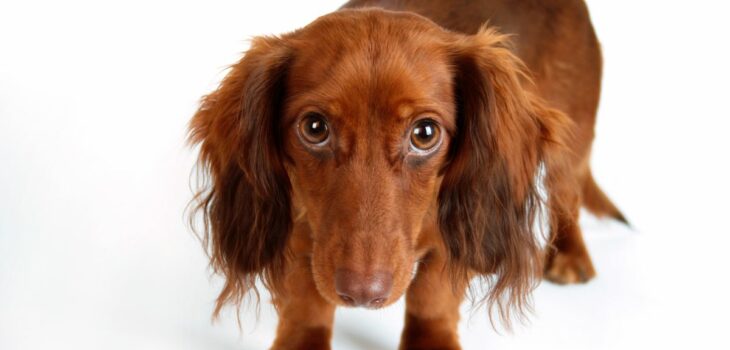Have you ever wondered what dog show group are dachshunds in? Are these little sausage dogs classed as terriers, or do they belong in the working dog group? Or perhaps they’re a sporting dog breed? Let’s find out!
What Are The 7 Major Dog Groups?
In most countries, dog breeds are split into groups for the purposes of competition and classification. These groups are created based on the characteristics and appearance of the dog as well as the purpose it was originally bred for.
Unfortunately, there is no international agreement on what these dog groups should be called! They tend to be grouped in a similar manner, but the name of the groups can differ considerably.
The American Kennel Club has 7 major dog groups:
Sporting Group
These are dogs used when hunting birds, intended to fetch and retrieve fallen prey. This group includes dog breeds such as Labradors, cocker spaniels, and German shorthaired pointers. You may also hear this group referred to as the gundog group.

Hound group
These dog breeds were all used to chase and catch prey. They are normally fast, have an amazing sense of smell, and relentless urge to pursue prey. This group includes basset hounds, greyhounds, and bloodhounds.
Working group
Working dogs were bred to assist humans, by pulling sleds, guarding flocks, and protecting families. This group includes breeds such as the rottweiler, great dane, and boxer.
Terrier group
Terriers were used to hunt underground prey, particularly rodents and vermin. They are relentless and persistent hunters and will dig and burrow in pursuit of their prey. Common terriers include the bull terrier, west highland white terrier, and border terrier.

Toy Group
Toy dog breeds have just one purpose in life – to keep humans company! These were the first dog breeds to developed exclusively as pets, without any other use such as hunting or guarding. Popular toy dog breeds include the chihuahua, pug, and Yorkshire terrier.
Herding Group
As the name suggests, these dogs were used for herding other animals and working with livestock on farms. You may also hear this group referred to as the pastoral group. Dogs in the herding group include the old English sheepdog, German shepherd, and Pembroke welsh corgi.
Non-sporting Group
This final group of dog breeds is a bit of an odd one, as it contains all the breeds that do not fit into the first six groups! These are normally dogs that were bred for a specific purpose other than sports, hunting, or livestock management. This groups is also known as the utility group, and includes dog breeds such as the bulldog, dalmatian, and poodle.

What Dog Show Group Are Dachshunds In?
So, where do our beloved dachshunds fit into all this? To figure this out, we need to look at what dachshunds were bred for. Nowadays they are normally kept as family pets, but the origins of this breed were very different!
Dachshunds can be traced as far back as the 15th century, but it is in Germany in the 17th century where this breed really came into its own. The short-legged dachshund was hugely popular with hunters of badgers, as they were strong enough to go into dens and flush out their prey. Smaller dachshunds could also go into rabbit warrens and other small burrows.
You might assume that this means the dachshund is a terrier – after all, it was used to hunt prey under ground! However, it is actually classed as part of the hound group, as it will also pursue prey above ground.
The name dachshund translates as ‘badger hound’ in German, which also gives an indication of what group this breed is in.
Has A Dachshund Ever Won Best In Show?
In many of the major international dog shows, there is a championship class to decide which dog is the best in show. This is often controversial, as it will judge dogs of different breeds against each other. One of the most prestigious dog shows is the famous Westminster Dog Show, but to date a dachshund has never won best in show at this event.
But has a dachshund ever won a national dog show hound group? It is not unheard of for a dachshund to be crowned best in group, but they rarely succeed when it comes to best in show. Statistically, terrier breeds appear to be more likely to be voted best in show than hounds, but there is no apparent reason for this.
The problem lies in that judging different breeds of dog against each other can be very difficult, and ultimately comes down to the personal opinion and preferences of the judges. If you were asked to choose which was best out of a dachshund or a poodle, it would be pretty tough to decide how to compare the two!
Summary – What Dog Show Group Are Dachshunds In?
So, as we have learned, there are seven major dogs groups, where dogs are classified according to their characteristics, appearance, and the function they were originally bred for. Dachshunds are in the hound group, because they were originally bred to hunt prey such as badgers and rabbits. Sausage dogs may be small, but they have many of the normal characteristics of a hound – including a relentless ability to track down prey, and a loud, baying bark!
We would love to hear your thoughts about what dog show group dachshunds are in! Were you surprised to hear that your little wiener dog is actually classified as a hound rather than a terrier? Or maybe you’ve got some questions about how to find the best dog show to enter your dog in? Leave a comment below and we will get back to you!





